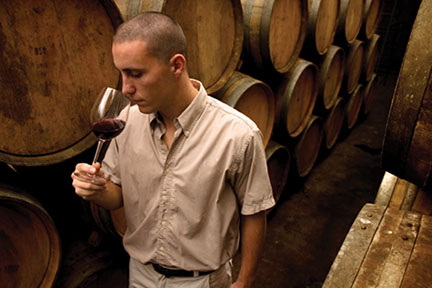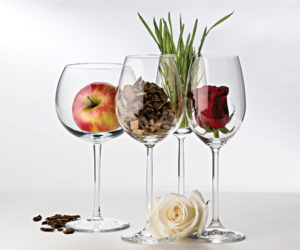
What Goes Wrong
The first step for me is to detect any flaws. Flaws are off-flavors that exceed the taster’s sensory threshold. Sensitivity to a flaw, such as vinegar, varies with the nose’s ability to pick up that component as well as a person’s tolerance for that character in a wine.
A wine with a noticeable flaw, whether the origin is chemical, spoilage organisms, viticultural, or simply cellar neglect, immediately becomes unacceptable to me, regardless of any of its other attributes. One flaw that actually is a balance issue is an over-oaked wine. Those that remind me foremost of a lumber yard or a two-by-four, I consider unacceptable.
Aroma and Flavor Profile
The next things I examine are the types of characters the Cabernet displays. Some Cabernets are technically free of flaws but carry a group of flavors that are simply unappealing. These flavors might be heavy earthy notes or swampy aromas. Even vegetal (vegetable) notes can be excessive. Judges downgrade these wines based on the “flavor message” they send.
My personal list of good characters includes red plum, black cherries, dark chocolate, vanilla cream, loam, minerals, and mocha. I have judged with several people for whom cedar, bell peppers, or dry herbs were key parts of Cabernet’s varietal profile and who would downgrade any wine lacking them.
All Things Equal
Balance is a classic term, but it is truly a critical aspect of rating a Cabernet. One of the most difficult things for a winemaker to achieve is a great mouthfeel. In judging I try to examine the balance of the wine’s structure. I ask myself whether the wine is overly tannic, excessively tart, thin and watery, or contains too much alcohol?
I prefer to find a round and powerful texture with a seamless integration of its parts, mouth-filling and graceful and with a very long, rich finish. Oak balance is also an important criterion, one that varies greatly for each judge and that can change with market trends as well.
Most everyone agrees that a sweet, oaky aroma and long, rich, oak-influenced finish are integral parts of today’s Cabernet. Cabernet styles can vary. A wine might be very tannic, very alcoholic, very acidic, and very oaky, yet still be in balance. Conversely, a gentle wine could have a balance of components at a different level and still be outstanding. Recognizing a more delicate wine is one of the most difficult jobs of a taster. The tendency, especially when the samples are numerous, is for the expressive, showy, big, and oaky wines to be ranked highly and the graceful-finesse Cabernets to be overlooked.
Style Goals
Next, when evaluating a Cabernet, I look at what I perceive to be the winemaker’s target style. This can be really tricky, like putting words in someone’s mouth. Nonetheless, I can award a high mark to a young, fruity, easy-to-drink Cabernet that aspires only to be a casual, pleasant drink and at the same time appreciate and reward an over-the-top monster that is built for many years of cellar aging. Both need to be properly expressed within their style.
Regional character has been talked about quite often. For me, however, it is of low importance. I like a Cabernet for the pleasure it gives, and nothing can go beyond that. I think looking for regional personality — “dusty” Cabernets from California’s Rutherford area, for example — is a distraction when judging and can often confuse the evaluation. It would be a big mistake to award an otherwise unappealing Cabernet simply because it displays its origin. Likewise, to dismiss an attractive wine because its region is not supposed to taste that way would be a crime. Basically, I believe that regardless of its origin, if a wine is a pleasure to taste it should be awarded high marks.
Making It to the Top
Only samples that make it through those tests successfully can then be considered for an upper-level classification. These are the wines that rise above the acceptable, above even the good wines, to a level of perfection or greatness. These are the samples that stand out in the flight, the ones you want to sample several more times. These are the Cabernets that make you say “wow!”
We all have certain buzz words when something gives real pleasure. My notes most often contain the word “awesome” when I taste a wine like this. These wines are flawless and clean, wines of great harmony and complexity, ones that contain the flavors I prefer, and wines that fit perfectly in their style goals.
Evolving Cabernets
At Kathryn Kennedy Winery, we believe in creating complex Cabernets that display the influence of vintage. As a result, we rarely try to change the wine’s character toward a consistent style.
Although home winemakers generally taste their young wines, I do not for several months. The logic is that if I have grown supreme grapes, produced clean wine, and have a deep trust in the terroir of the site, I have no need to manipulate the young wine toward a certain direction. So with no real need for change, what need do I have for taste evaluation? Basically, I don’t want to intercede, so I don’t need confusing sensory information that can accompany very young wine.
We do run lab analysis rather than relying on taste during this time to monitor malic acid, residual sugar, and volatile acidity. My first real taste evaluation happens in spring following the vintage. My objective then is to confirm the vintage’s personality and check for reductive aromas.
Evolving Flavors
Starting at six months I want to see pure fruit aromas, highly intense, vibrant, and featuring blueberry, violet, and crushed flowers. We almost never notice herbal notes, but they do exist in the distant background, adding a breadth to the aromas. A slight berry-pie-crust note shows some yeast influence, but the wine should not express any hydrogen sulfide (rotten eggs) or earthy notes.
The texture should be acidic, tight, lean, and at the same time ripe and dense, with a mouth-watering, sweet fruit finish. No complexity of cedar, chocolate, or herbs is necessary at this time. As the wine comes to its first birthday, I want to see more plum, red fruits, and richer berry aromas. There also should be, of course, noticeable oak reminiscent of berry pie with the crust and vanilla ice cream. I might like to taste chocolate-covered raisins at this time as well.
All these should be very deep and persistent. The wine should not seem open (with individual flavors emerging), forward, or mature. Then at 18 months I find a closed wine (flavors are concentrated and harder to distinguish) with more tannin plus more earth (tar) and fewer simple flavors that can be described as grape, soda pop, bubble gum. However, as the second summer comes along, the Cabernets should come to a higher state. A reserve character becomes present, with rich, oily aromas and smoother texture added to the depth of flavor found earlier.
Our wines are bottled with a backward condition. That is to say they are not polished and ready to drink. Our estate Cabernets are designed for a decade or more of cellaring. We believe refinement and classic excellence come about only through patience and years of bottle aging.
A Final Word
We are very fortunate that Cabernets can come in a range of styles. When evaluating the sample in front of you, remember the winemaker (maybe you!) and his hard work. Remember the consumer, too. There are all kinds of Cabernets, and each deserves basic respect.
Don’t fall into the trap of being constantly critical. It’s much easier to cut a wine down than to stick your neck out and say “I like this.” We are lucky to live in a time when Cabernet Sauvignon has continued to be improved and refined to a level worthy of its noble standing.



